


C57BL/6-Cd3etm2(hCD3E)Bcgen Dll3tm1(DLL3)Bcgen/Bcgen • 112939
| Product name | B-hCD3E/hDLL3 mice |
|---|---|
| Catalog number | 112939 |
| Strain name | C57BL/6-Cd3etm2(hCD3E)Bcgen Dll3tm1(DLL3)Bcgen/Bcgen |
| Strain background | C57BL/6 |
| NCBI gene ID | 12501, 13389 |
| Aliases | IMD18, T3E, TCRE, SCDO1 |
on this page
Gene targeting strategy for B-hCD3E/hDLL3 mice. The exons 2-6 of mouse Cd3e gene that encode extracellular domain were replaced by human counterparts in B-hCD3E/hDLL3 mice. The genomic region of mouse Cd3e gene that encodes transmembrane domain and cytoplasmic portion was retained. The promoter, 5’UTR and 3’UTR region of the mouse gene were also retained. The chimeric CD3E expression was driven by endogenous mouse Cd3e promoter, while mouse Cd3e gene transcription and translation will be disrupted.
The exons 2-7 of mouse Dll3 gene that encode extracellular domain were replaced by human counterparts in B-hCD3E/hDLL3 mice. The genomic region of mouse Dll3 gene that encodes signal peptide, transmembrane domain and cytoplasmic portion was retained. The promoter, 5’UTR and 3’UTR region of the mouse gene were also retained. The chimeric DLL3 expression was driven by endogenous mouse Dll3 promoter, while mouse Dll3 gene transcription and translation will be disrupted.
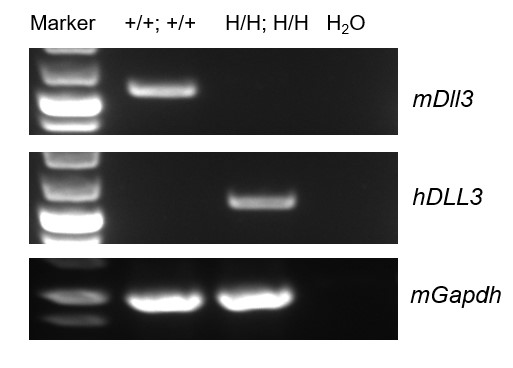
Species specific analysis of DLL3 gene expression in wild-type C57BL/6JNifdc mice and homozygous humanized B-hCD3E/hDLL3 mice by RT-PCR. Lung was collected from wild-type C57BL/6JNifdc mice (+/+; +/+) and homozygous B-hCD3E/hDLL3 mice (H/H; H/H). Mouse Dll3 mRNA was detectable only in wild-type C57BL/6JNifdc mice. Human DLL3 mRNA was detectable only in homozygous B-hCD3E/hDLL3 mice, but not in wild-type C57BL/6JNifdc mice. The positive band was confirmed to be correct by sequencing.
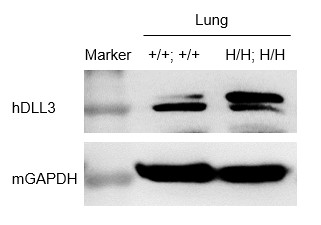
Strain specific DLL3 expression analysis in wild-type C57BL/6JNifdc mice and homozygous humanized B-hCD3E/hDLL3 mice by western blot. Lung was collected from wild-type C57BL/6JNifdc mice (+/+; +/+) and homozygous B-hCD3E/hDLL3 mice (H/H; H/H). Protein expression was analyzed with anti-DLL3 antibody by western blot. Mouse DLL3 was detectable in wild-type C57BL/6JNifdc mice due to the cross-reactivity of antibodies. Human DLL3 was detectable in homozygous B-hCD3E/hDLL3 mice.
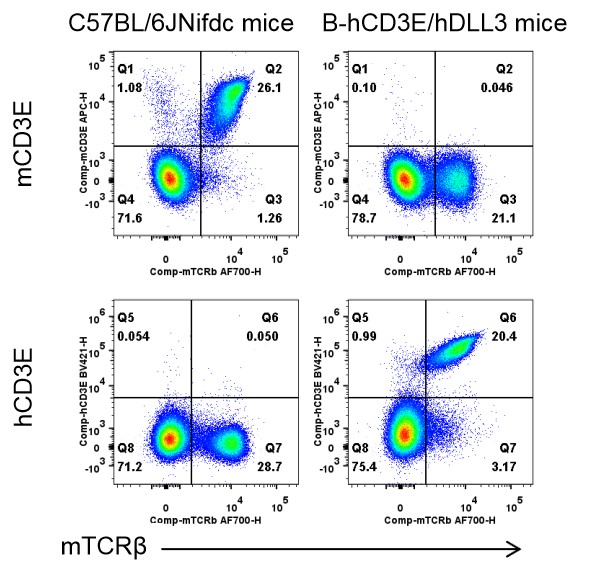
Strain specific CD3E expression analysis in wild-type C57BL/6JNifdc mice and homozygous humanized B-hCD3E/hDLL3 mice by flow cytometry. Splenocytes were collected from wild-type C57BL/6JNifdc mice and homozygous B-hCD3E/hDLL3 mice. Protein expression was analyzed with anti-mouse CD3E antibody (Biolegend, 100312) and anti-human CD3E antibody (BD Horizon™, 562426) by flow cytometry. Mouse CD3E was only detectable in wild-type C57BL/6JNifdc mice. Human CD3E was exclusively detectable in homozygous B-hCD3E/hDLL3 mice, but not in wild-type C57BL/6JNifdc mice.
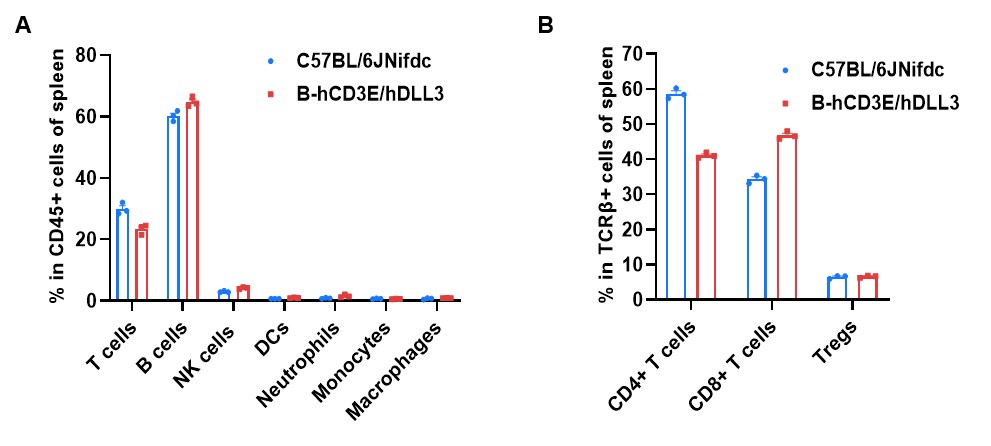
Frequency of leukocyte subpopulations in spleen by flow cytometry. Splenocytes were isolated from wild-type C57BL/6JNifdc mice and homozygous B-hCD3E/hDLL3 mice (female, 6-week-old, n=3). A. Flow cytometry analysis of the splenocytes was performed to assess the frequency of leukocyte subpopulations. B. Frequencies of T cell subpopulations.
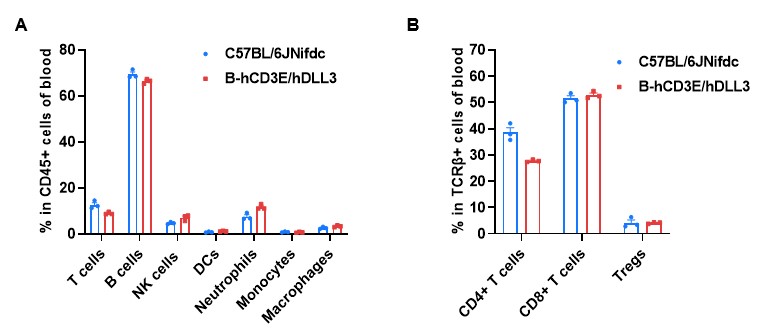
Frequency of leukocyte subpopulations in blood by flow cytometry. Blood cells were isolated from wild-type C57BL/6JNifdc mice and homozygous B-hCD3E/hDLL3 mice (female, 6-week-old, n=3). A. Flow cytometry analysis of the blood cells was performed to assess the frequency of leukocyte subpopulations. B. Frequencies of T cell subpopulations.
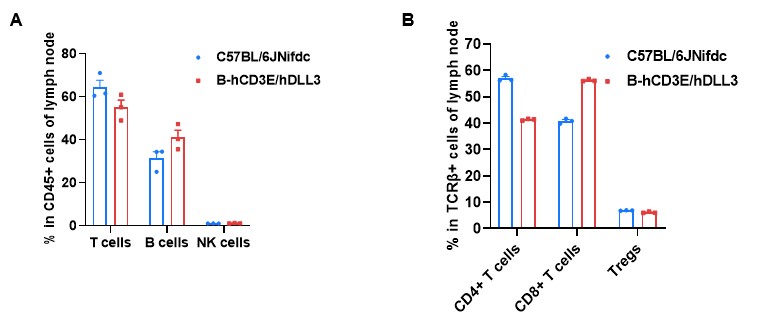
Frequency of leukocyte subpopulations in lymph nodes by flow cytometry. Leukocytes were isolated from wild-type C57BL/6JNifdc mice and homozygous B-hCD3E/hDLL3 mice (female, 6-week-old, n=3). A. Flow cytometry analysis of the leukocytes was performed to assess the frequency of leukocyte subpopulations. B. Frequencies of T cell subpopulations.